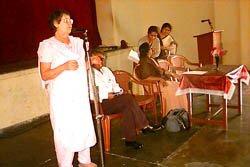 On February 23, she spoke to approximately 350 students at the Huddard High School, the first of the series. She was presented with a massive bouquet of flowers upon her entrance to the school auditorium .The Principal, Mr. Vincent, then introduced her as internationally recognized for her research on the impacts of contamination on human health and for her work in assisting various countries with decreasing pollution.
On February 23, she spoke to approximately 350 students at the Huddard High School, the first of the series. She was presented with a massive bouquet of flowers upon her entrance to the school auditorium .The Principal, Mr. Vincent, then introduced her as internationally recognized for her research on the impacts of contamination on human health and for her work in assisting various countries with decreasing pollution.
Dr. Guillette began her speech with a discussion of the various types of pollutants, especially those found in the Kanpur area. She asked the students how many man-made chemicals they thought were in their bodies. The reply was about 150, so they were surprised to hear that the average person has a body burden of about 700 chemicals, with those people in heavily contaminated areas carrying even more. The students learned that such chemicals and heavy metals enter the body through breathing, skin absorption and ingestion. The persistence of many chemicals was presented in terms of the pesticide, DDT, where it takes 30 years for half of the amount present to breakdown.
As an example of how contamination affects the ways hormones influence cell function, and communicate between cells, was given by Dr. Guillette pretending to be a cockroach sprayed with insecticide. She began shaking her body and arm to demonstrate how the insecticide disrupts communication between nerve endings, and then became still to represent death. The students appreciated the use of humor in this serious talk. Dr. Guillette stressed that the people are usually not exposed to enough insecticide to cause such a violent reaction but that other types of problems occur because of disruption in the endocrine, or hormonal, system. While disease, such as cancer or increased infections is obvious with exposure, other problems also occur. The boys were surprised to hear of the decreased sperm count in men around the world, while girls reacted to the increased numbers of fertility problems in females. All were wide-eyed upon learning about how contamination, of various sorts, changes the age when puberty occurs. The effect on brain function was discussed. Drawings of a person, done by teenagers not drinking or using contaminated water and those children who drank contaminated water were placed on the blackboard. The unexposed teenagers had made a complete person, dressed in clothes and with styled hair. This drawing by the teenaged using contaminated water was similar to what a normal four year old might do, with the arms coming out the head, no body, just legs extending downward.
 The means of protecting oneself from multiple exposures was presented by class members on stage. One boy played the role of the typical teenager. Others students portrayed the various contaminates found in Kanpur. As the boy discussed his day, from washing with perfumed soap, drinking milk, riding his bike in traffic, etc., the “contaminants” gave him a card representing his exposure to a compound. He had about a dozen cards by the end of the school time. The ways his exposure could be eliminated, or decreased, were presented, with a card removed from his hand each time he took a simple precaution, such as not breathing fumes from burning plastic. He finished the demonstration with three remaining cards, showing that exposures could not be completely eliminated but certainly decreased.
The means of protecting oneself from multiple exposures was presented by class members on stage. One boy played the role of the typical teenager. Others students portrayed the various contaminates found in Kanpur. As the boy discussed his day, from washing with perfumed soap, drinking milk, riding his bike in traffic, etc., the “contaminants” gave him a card representing his exposure to a compound. He had about a dozen cards by the end of the school time. The ways his exposure could be eliminated, or decreased, were presented, with a card removed from his hand each time he took a simple precaution, such as not breathing fumes from burning plastic. He finished the demonstration with three remaining cards, showing that exposures could not be completely eliminated but certainly decreased.
The question and answer time centered on what students could do to prevent the release of additional contamination into the area. Education of the general public was seen as very necessary, and the protests of continuing discharge of waste.
After the presentation, K. V. Vincent, the Principal of Huddard High School, had a private discussion with Dr. Guillette and Rakesh K Jaiswal, Eco Friends Executive Secretary. Mr. Vincent gave profuse thanks for the presentation. The idea of encouraging teachers to have students write letters to various governmental officials as a class assignment was also appreciated.
